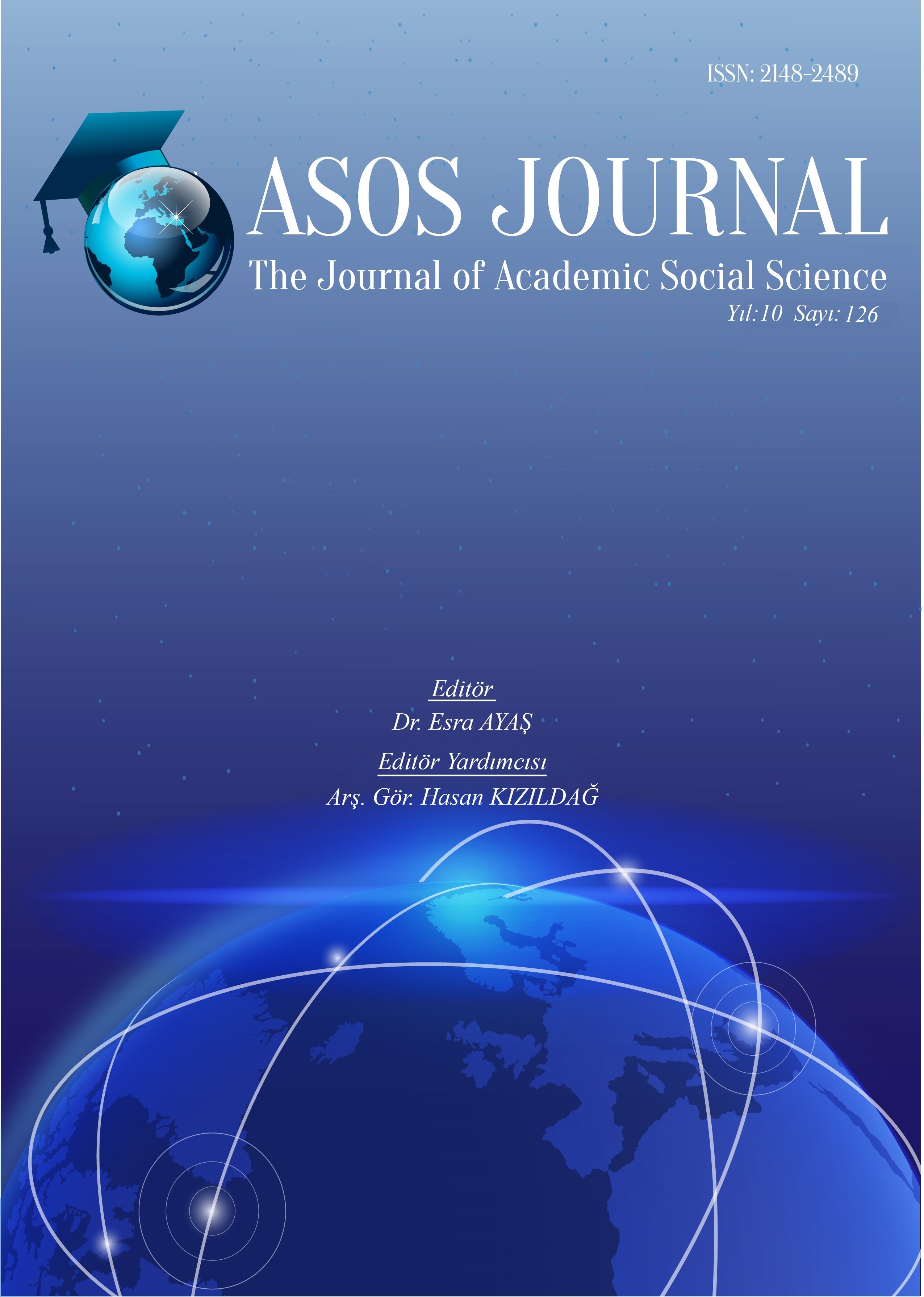THOMAS HARDY’NİN “ABSENT-MINDEDNESS IN A PARISH CHOIR” BAŞLIKLI KISA ÖYKÜSÜNDE SÖZ SANATLARI VE TÜRKÇEYE ÇEVİRİ STRATEJİLERİ
Author :
Abstract
Bu çalışmanın amacı Thomas Hardy’nin Absent-Mindedness in a Parish Choir başlıklı kısa öyküsündeki söz sanatlarının Türkçeye hangi çeviri stratejileri ile aktarıldığını açığa çıkarmak ve eşdeğerlik kavramı ekseninde bir değerlendirme yapmaktır. Bu bağlamda, eser dâhilinde benzetme (7), abartma (2), aliterasyon (ses yinelemesi) (1), asonans (yarım uyak) (1), anıştırma (1), imgelem (1) olmak üzere 8 bağlamda 13 söz sanatı belirlenmiştir. Söz sanatlarının İngilizceden Türkçeye çevirileri Baker (2018) tarafından öne sürülen ve profesyonel çevirmenler tarafından kullanılan çeviri stratejilerine ve Koller (2011) tarafından önerilen eşdeğerlik türlerine göre çözümlenmiştir. Çeviri değerlendirmesi sonucunda çevirmenin Baker’ın çeviri stratejilerine uygun olarak söz sanatlarını kültürel denkliklerini kullanarak ve ilintili sözcüklerle açımlayarak çevirme eğiliminde olduğu tespit edilmiştir. Ayrıca, çevirmenin kaynak metnin üslubundan taviz vermediği ve eşdeğerliği koruyabildiği de saptanmıştır. Çalışmanın bulguları ve ilgili literatür dikkate alındığında, çevirmenlerin kültürel farklılıkların ve çeviri stratejilerinin farkında oldukları sürece yazınsal zorlukların üstesinden gelebilecekleri sonucuna varılmıştır.
Keywords
Abstract
This study aims to find out the figures of speech in the short story Absent-Mindedness in a Parish Choir by Thomas Hardy and determine the strategies used in the translation of the figures of speech from English into Turkish. 13 figures of speech; including simile (7), hyperbole (2), alliteration (1), assonance (1), allusion (1), imagery (1), were found in 8 contexts in the short story. The translation of figures of speech from English into Turkish was analysed according to the strategies put forward by Baker (2018), namely strategies used by professional translators and types of equivalences suggested by Koller (2011). As a result of translation evaluation, it was found that the translator tends to translate the figures by using their cultural equivalences and paraphrasing by related words respecting Baker’s translation strategies. Besides, it is worth mentioning that the translator makes no concessions of the tone of the source text and can maintain the equivalency proficiently. Considering the findings of the study and relevant literature, it was concluded that translators can overcome literary difficulties as long as they are aware of the cultural (dis)similarities and translation strategies.
Keywords
- Baker, M. (2018). In Other Words. Oxon and New York: Routledge.
- Biyografya Beta, Retrieved on: 17.01.2022, https://www.biyografya.com/biyografi/1163
- Britannica, Retrieved on 17.01.2022, https://www.britannica.com/biography/Thomas-Hardy
- Cambridge Dictionary, (English), English dictionary. Retrieved on: 18.12.2021, https://dictionary.cambridge.org/
- Catford, John, C. (1965). A Linguistic Theory of Translation. Londra: Oxford University.
- Collins Dictionary, Collins English Dictionary. Retrieved on 18.12.2021, https://www.collinsdictionary.com/dictionary/english/figure-of-speech
- Hardy, T. (2018). Kilise çalgıcılarının aymazlığı (C. Üster, Çev), İngiliz ve Amerikan Edebiyatında Kısa Öykünün Büyük Ustaları (pp. 55-58). İstanbul: Türkiye İş Bankası Kültür Yayınları.
- Jakobson, R. (1959). On Linguistic Aspect of Translation. On Translation. Cambridge: MA. Harward University Press.
- Kansu-Yetkiner, N. (2007). Çevirmen kararları ve sorumluluğu bağlamında bir kampanya metninin çözümlenmesi. LITTERA Edebiyat Yazıları, Vol. 20.
- Koller, W. (1979). Einführung in die Übersetzungswissenschaft. Heidelberg: Quelle and Meyer.
- Koller, W. (1987). Einführung in die Übersetzuungswissenschaft. Heidelberg: Quelle & Meyer.
- Koller, W. (2011). Einführung in die Übersetzungswissenschaft. (8.Auflage). Tübingen: A. Francke Verlag.
- Literary Devices, Definition and Examples of Literary Terms, Retrieved on 19.12.2021 and 17.01.2022, https://literarydevices.net/
- Merriam-Weber Dictionary, Retrieved on 18.12.2021, https://www.merriam- webster.com/dictionary/figure%20of%20speech
- Nalcıoğlu, A. U. (2015). Edebi eserlerde çeviri sorunları. Atatürk Üniversitesi Edebiyat Fakültesi Sosyal Bilimler Dergisi Journal of Social Sciences, 55, 1-9.
- Newmark, P. (1988). A Textbook of Translation. Hertfordshire: Prentice Hall International.
- Nida, E. (1964). Toward a Science of Translation. Leiden: Brill.
- Panou, D. (2013). Equivalence in translation theories: A critical evaluation. Theory and Practice in Language Studies, 3(1), 1-6.
- Soysal, F. (2012). Eşdeğerlik ve Skopos Kuramının Çeviri Eylemine Uygulanabilirlikleri: Bertolt Brecht Çevirilerine Eleştirel Bir Yaklaşım. Selçuk Üniversitesi Sosyal Bilimler Enstitüsü, Yayımlanmamış Yüksek Lisans Tezi.
- Silva Rhetoricae, The Forest of Rhetoric, Retrieved on: 19.12.2021, http://rhetoric.byu.edu/
- Tok, Z. (2019). Şiir çevirisi ve Fransızcadaki söz sanatlarının Türkçeye aktarımı. International Social Sciences Studies Journal, 5(34), 2253-2260.
- Tosun, M. (2006). The responsibility of the translator by the intercultural transference of information. Journal of Human Sciences, 3(2). Retrieved from https://www.jhumansciences.com/ojs/index.php/IJHS/article/view/185https://literarydevices.net/asson ance/
- Ünsal, G. (2018). Söz sanatlari ve reklam çevı̇rı̇sı̇ üzerı̇ne gözlemler. International Journal of Language Academy, 6(4), 107-123.





